The Civil War in newspapers…
April 29, 2013 by TimHughes · 1 Comment
Could there be a period in American history which fascinates and intrigues more than the Civil War? As we celebrate the 150th anniversary of the battle between the North and the South, collecting interest in genuine newspapers which reported the news as it was happening, remains strong among the relatively small number of rare newspaper collectors. Any visit to a Civil War collector’s show will give evidence to the high prices of genuine memorabilia, from guns to uniforms to every bit and scrap of war-related material a collector might desire. But newspapers remain a very welcomed low-priced option, perhaps largely because they have yet to be discovered by majority of Civil War collectors.
But that has always been the case with this hobby, regardless of the time period. Rare newspaper have always remained relatively unknown in the world of historical collectables—a reality which continues to amaze—but its consequence has provided one of the benefits of those who enjoy the hobby: low prices. Across the entire spectrum of collectables, be they coins, stamps, furniture, books, autographs, toys—you name it–items of comparable age to newspapers are much higher than newspapers.
And what a world is available to the Civil War collector who discovers rare newspapers. You name the battle or political event that happened from 1861 to 1865 and it will be found in a newspaper of the day. And this hobby allows a collection to showcase not just the events of the war but the lead-up to the conflict between the states, as the issue of slavery and the troubling relationship between the Northern and Southern states making news for more than a decade before the outbreak of war.
From the Battle of Fort Sumter to the assassination of Abraham Lincoln, a collector can create a notable collection of newspapers as large or small as their budget will allow. Some might focus on the top ten most significant battles of the Civil War (see previous post) and include newspapers with accounts of Fort Sumter, First and Second Bull Run (Manassas), Hampton Roads (the Monitor vs. the Merrimac), Shiloh (Pittsburg Landing), capture of New Orleans, Antietam, Gettysburg, Vicksburg, Chickamauga, fall of Atlanta, Savannah and Richmond as well as the surrender of General Lee to U.S. Grant. Wikipedia offers an excellent and very inclusive list of all the battles of the Civil War which can be used as a checklist for the collector seeking the most notable events of the war.
Typically daily newspapers have war reports on the front page with additional news on inside pages as well, and a select few included graphics. The “New York Times”, “New York Tribune” “New York Herald” and the “Philadelphia Inquirer” are—in my opinion—the “big 4” titles of the war, as they more than most printed Civil War maps and other war-related graphics on their front pages. Such issues remain favorites for framing and display.
Not to be overlooked are the political events and speeches which were perhaps more significant than the battles, including the election and inauguration of Abraham Lincoln, the Emancipation Proclamation and the Gettysburg Address. All events appeared in newspapers within a day of their happening.
Yet another area of focus for various collectors is the gathering of contemporary reports surrounding certain historic figures such as Abraham Lincoln, Robert E. Lee, Ulysses S. Grant, “Stonewall” Jackson, George Meade, James Longstreet, William Sherman, Jefferson Davis, Ambrose Burnside, Nathan B. Forrest, Colonel Robert Shaw, John Hunt Morgan (and his raiders), to name a few. Textbooks simply cannot capture the essence of these noteworthy individuals in the same way newspapers can.
Some collectors might focus on the Civil War from the Confederate perspective as newspapers from the Southern state are available, albeit more rare, and offer an interesting perspective on the events of the war. Issues from Richmond, the capital of the Confederacy, offer some of the best coverage of the war as all news eventually found its way to Richmond. And the editorials offer fascinating reading in the “Daily Richmond Examiner” or the “Daily Dispatch”. Charleston newspapers also offer great coverage, after all the war began in its harbor. The “Charleston Daily Courier” was one of the best, and one of but a few Southern newspapers which printed in the masthead “Confederate States of America”. Venturing beyond the more “common” of the Confederate titles, newspapers from other states are available, a few of the more accessible being the “Daily Progress” (from Raleigh) and the “Louisville Daily Courier” from Kentucky. The “Daily Memphis Appeal” is an intriguing title, as during its Civil War history it was chased by the Yankees out of Memphis and published in 8 other Confederate cities before succumbing in the final weeks of the Civil War.
A “Confederate” newspaper from the North might seem like a oxymoron, but “The Crisis” from Columbus, Ohio, was an intriguing newspaper by a copperhead publisher who was very much opposed to the Lincoln administration and strongly supported the Confederate effort believing that slavery could not be prohibited by law.
One cannot mention newspapers of the Civil War without discussing “Harper’s Weekly”, the illustrated newspaper which put all the action, drama and cruelty of war into the homes of every American. For the first time, citizens were able to see what their leaders looked like, as an abundance of portraits of the Civil War officers appeared throughout the war years, not to mention the great wealth of battle scenes and city views not found elsewhere during the Civil War. Not to be outdone by the Yankees, the Confederates created their own version of “Harper’s Weekly”, titled the “Southern Illustrated News” published in Richmond, but it was a poor imitation at best. It’s lack of success resulted in a considerably smaller circulation and obviously more rare title for collectors today.
Whatever your interest in the Civil War, collectible newspapers have much to offer. With prices relatively low for 150 year old items and containing virtually every event which happened during that fascinating era, a notable collection can be amassed which can be enjoyed and admired without breaking the bank. A fascinating world awaits those who discover this interesting collectible.
Pictures… Is a thousand words always enough?
January 27, 2013 by GuyHeilenman · Leave a Comment
 The New York Times of October 20, 1862 includes a wonderful article which eloquently combats any romanticized view of the Civil War. Sometimes, far from the realities of the slaughter (in time and distance), we fail to properly connect with the tragedy and horror experienced by so many. The article includes, in part, “There is one side of the picture that the sun did not catch, one phase that has escaped photographic skill it is the background of widows and orphans, torn from the bosom of their natural protectors by the red remorseless hand of Battle, and thrown upon the brotherhood of God. Homes have been made desolate, and the light of life in thousands of hearts has been quenched forever. All of this desolation imagination must paint — broken hearts cannot be photographed.” Rather than say more, we’ll let the article speak for itself. The actual original article itself may be viewed in full at:
The New York Times of October 20, 1862 includes a wonderful article which eloquently combats any romanticized view of the Civil War. Sometimes, far from the realities of the slaughter (in time and distance), we fail to properly connect with the tragedy and horror experienced by so many. The article includes, in part, “There is one side of the picture that the sun did not catch, one phase that has escaped photographic skill it is the background of widows and orphans, torn from the bosom of their natural protectors by the red remorseless hand of Battle, and thrown upon the brotherhood of God. Homes have been made desolate, and the light of life in thousands of hearts has been quenched forever. All of this desolation imagination must paint — broken hearts cannot be photographed.” Rather than say more, we’ll let the article speak for itself. The actual original article itself may be viewed in full at:
Brady’s Photographs; Pictures of the Dead at Antietam
The Traveler… The Emancipation… the last look… and today…
January 21, 2013 by The Traveler · Leave a Comment
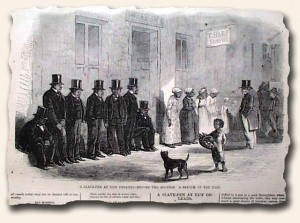 This week I traveled 150 years back in time and through the activities of the Civil War via the Harper’s Weekly dated January 24, 1863. This issue contains a double-page illustration by Thomas Nast entitled “The Emancipation of the Negroes, January, 1863 – The Past and The Future.” Mr. Nast shows their present life in the center circle, of a happy home including a picture of President Lincoln hanging on the wall. The illustrations to the left show obstacles they had to endure — being sold at auctions and separated from loved ones, beatings, and being chased (if running away). The illustrations to the right show what they are looking to in the future with the implementation of the Emancipation Proclamation — owning a home, children going to public school, being treated fairly by the employer and being paid for working.
This week I traveled 150 years back in time and through the activities of the Civil War via the Harper’s Weekly dated January 24, 1863. This issue contains a double-page illustration by Thomas Nast entitled “The Emancipation of the Negroes, January, 1863 – The Past and The Future.” Mr. Nast shows their present life in the center circle, of a happy home including a picture of President Lincoln hanging on the wall. The illustrations to the left show obstacles they had to endure — being sold at auctions and separated from loved ones, beatings, and being chased (if running away). The illustrations to the right show what they are looking to in the future with the implementation of the Emancipation Proclamation — owning a home, children going to public school, being treated fairly by the employer and being paid for working.
This illustration has an accompanying article that describes the illustration and also includes text from the Tribune of March 11, 1859, which dealt with the largest single sale of humans (slaves) in the United States. Mr. Pierce M. Butler of a city near Savannah, Georgia, sold 486 slaves — men, women and children — to pay his debts. This gives a prospective of what the slaves had to endure as they were being separated from each other as family members and long term friends.
As a contrast , this issue also presents a look into the past with an illustration and small article, “A Slave-Pen at New Orleans – Before the Auction. A Sketch of the Past.”
Today we also celebrate Martin Luther King, Jr. day. Let us all remember his famous words… “Free at last. Free at last. Thank God Almighty we are free at last.“
~The Traveler
The Assassination of Abraham Lincoln… one the the very best…
January 18, 2013 by GuyHeilenman · Leave a Comment
The April 22, 1865 issue of the National Police Gazette, New York, printed what many consider to be the best illustrated newspaper related to the assassination of President Abraham Lincoln. Judge for yourself. Regardless of your final analysis, please enjoy the images from this incredible authentic newspaper compliments of Timothy Hughes Rare & Early Newspapers… History’s Newsstand… via Pinterest:
A gem in the American Antiquarian Society… Charleston Mercury Extra…
January 14, 2013 by TimHughes · Leave a Comment
In celebration of its 20oth anniversary the American Antiquarian Society published a beautiful exhibition catalog titled “In Pursuit Of A Vision – Two Centuries of Collecting at the American Antiquarian Society”. Featured are a fascinating array of books, documents, maps & other paper ephemera, as well as several very rare & unusual newspapers we felt worthy of sharing with our Rare & Early Newspapers’ collectors (with permission from the A.A.S.).
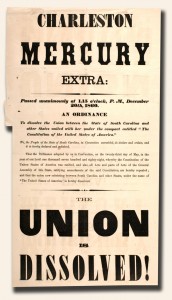 “Charleston Mercury Extra“, December 20, 1860
“Charleston Mercury Extra“, December 20, 1860
The divisive political events of the 1850s had pitted North against South on numerous issues, including the expansion of slavery into the western territories, tariffs on goods such as cotton, and broader concepts of states’ rights vs. federal law. Political compromises made throughout the decade in an attempt to keep the nation together effectively collapsed with the election of Abraham Lincoln in November 1860. South Carolina, heir to the legacy of states’ rights lion John C. Calhoun, was the first to address the possibility of leaving the Union. On November 10, 1860, four days after the presidential election, South Carolina brought the issue to a head by calling a secession convention for the following month.
Considered by virtue of timing to be the first Confederate imprint, this broadside announced to the public the convention’s declaration, on December 20, 1860, that South Carolina would secede from the United States. This sheet was removed from a wall in Charleston by the Boston-born author Caroline Howard Gilman (1794-1888), who had moved permanently to Charleston following her marriage to the Rev. Samuel Gilman. Gilman mailed the broadside to her daughter Eliza in Salem, Massachusetts. Eliza in turn presented the document to AAS member Nathaniel Paine who, heeding the Society’s call to preserve all printed material relating to the unsettling national events, passed the broadside along to AAS.
A high-resolution image of this issue is viewable at: American Antiquarian Society, #47
Newspaper Confederate bank note creates a crisis…
October 1, 2012 by TimHughes · 2 Comments
Having recently come across the Feb. 24, 1862 issue of “The Philadelphia Inquirer” (see photo) it reminded me of what this innocent looking front page image of the Confederate five dollar note did in creating a crisis in the Confederate Treasury.
Several months ago the “Opinionator” blog of the New York Times did a very nice piece on the fascinating history of this note and its consequences, which we share with our collectors:
 In March 1862, an unusual ad began appearing in Northern newspapers. Among the shops selling pianos and patent medicines, sheet music and sewing machines, this one stood out: it promised “perfect fac-similes” of Confederate currency. There were seven kinds of notes for sale, and testimonials from The New York Tribune and others praising the replicas for their high quality and low prices. Five cents bought you one. Two dollars bought a hundred. Fifteen dollars bought a thousand. The word “counterfeits” never appeared. These were “Mementos of the Rebellion,” sold by a Philadelphia shopkeeper named Samuel Curtis Upham.
In March 1862, an unusual ad began appearing in Northern newspapers. Among the shops selling pianos and patent medicines, sheet music and sewing machines, this one stood out: it promised “perfect fac-similes” of Confederate currency. There were seven kinds of notes for sale, and testimonials from The New York Tribune and others praising the replicas for their high quality and low prices. Five cents bought you one. Two dollars bought a hundred. Fifteen dollars bought a thousand. The word “counterfeits” never appeared. These were “Mementos of the Rebellion,” sold by a Philadelphia shopkeeper named Samuel Curtis Upham.
Upham didn’t look like a counterfeiter. He didn’t hide out in the woods or perform daring jailbreaks. He didn’t run from the police. He was a respectable small-business owner and devoted Northern patriot. He ran a store that sold stationery, newspapers and cosmetics. But he was also an entrepreneur with an eye for easy profit, and the Civil War offered the business opportunity of a lifetime: the ability to forge money without breaking the law. Confederate currency, issued by a government that was emphatically not recognized by the Union, had no legal status in the North, which meant Upham could sell his “fac-similes” with impunity.
Over the next 18 months he built the most notorious counterfeiting enterprise of the Civil War — one that also happened to be perfectly legal. His forgeries flooded the South, undermining the value of the Confederate dollar and provoking enraged responses from Southern leaders. He waged war on the enemy’s currency, serving his pocketbook and his country at the same time.
Upham first got the idea the month before, on Feb. 24, 1862. That day, customers kept coming into his shop to buy The Philadelphia Inquirer. Puzzled, he asked one of them what made that particular edition so popular. The answer was on the front page: the Inquirer’s editors had printed a copy of a five-dollar Confederate note. Philadelphians had never seen Rebel money before and were fascinated by it.
Upham saw a chance to cash in. He raced to the Inquirer’s offices, bought the plate of the note, and printed 3,000 copies on French letter paper. They sold extremely well. Along the bottom of each bill, he included a thin strip that read, in small print, “Fac-simile Confederate Note,” with his name and address. The tags could easily be clipped off, transforming the “fac-simile” into an excellent counterfeit.
After his first print run, Upham rapidly expanded his inventory. He took out ads in newspapers, promising to pay in gold for more specimens of Southern money. At first, it seemed possible that he sincerely thought of his reproductions as souvenirs. In early 1862, most Northerners still expected the war to be brief and glorious. They wanted “mementos of the Rebellion” before the Union crushed it. By the time Upham launched his publicity campaign in March, however, his business had clearly evolved from a modest retail operation into a high-volume wholesaling enterprise. No one needed 1,000 souvenirs: people were clearly using his products for a less innocent purpose.
By April, Upham’s fakes began appearing in Richmond, the Confederate capital. They caused a sensation at the Confederate Treasury Department, and a Treasury officer persuaded the editors of the Richmond Daily Dispatch to inform the public about the new threat. “This note is well calculated to deceive, and in nearly every particular is a fac-simile of the original,” they wrote, condemning the forgeries as “Yankee scoundrelism.” In May, the Dispatch discovered one of Upham’s notes with the margin bearing his name and address still attached. “Who is this man Upham?” they asked. “A knave swindler, and forger of the most depraved and despicable sort.”
By then, Upham had grown his business considerably. In an advertisement published in late May, he claimed to have sold half a million notes in the past three months. He now offered 14 varieties of Confederate notes, postage stamps, and “shinplasters” — fractional bills worth anywhere from 5 to 15 cents — and printed his fakes on real banknote paper. Ingeniously, he even fulfilled orders through the mail. For 50 cents, plus 18 cents for postage, customers throughout the Union could have a hundred of Upham’s notes delivered.
Southerners responded with outrage. They became convinced that Upham belonged to a covert Union plot to devalue the Confederate dollar. For the Philadelphia shopkeeper to be able to advertise his counterfeits openly and send them through the mail meant the authorities must have given him permission or, possibly, material support. Moreover, Union troops spent counterfeit Confederate cash in large quantities — evidence of “a deep laid scheme on the part of the thieving, counterfeiting North … to undermine the Confederate currency,” in the eyes of the Daily Richmond Examiner.
In the summer of 1862, Upham’s notes inundated northern Virginia, brought by Union forces marching south from Washington. A Southern journalist observed men “fortified with exhaustless quantities of Philadelphia Confederate notes,” which they used to buy everything from horses to sugar to tobacco. When one of the soldiers ended up a prisoner in Richmond, the Confederates found one of Upham’s advertisements on him. The shopkeeper’s counterfeits appeared “wherever an execrable Yankee soldier polluted the soil with his cloven foot,” fumed the Richmond Daily Dispatch.
By the summer of 1862, as fake cash flowed across the border in ever greater quantities, the Confederate leadership took notice. On Aug. 18, President Jefferson Davis discussed the threat in a message to the Confederate Congress. Counterfeit Confederate notes were “publicly advertised for sale” and furnished to “the soldiers of the invading army” with the full “complicity” of the Union government, Davis declared. Later that day, Confederate Treasury Secretary Christopher Memminger submitted a report to the House of Representatives that reiterated Davis’s concerns and singled out Upham’s role in the crisis: “[P]rinted advertisements have been found stating that the counterfeit notes, in any quantity, will be forwarded by mail from Chestnut street, in Philadelphia.” By then, forged bills had been found far from the Union border, in Atlanta, Savannah, Montgomery and other cities of the Deep South. There was “no means of knowing to what extent they have been circulated,” the Richmond Daily Dispatch warned.
Hamstrung by a disorganized government and mounting logistical challenges, the Confederacy couldn’t stanch the surge of counterfeit currency. Despite Southern claims, however, it’s unlikely that the Union government ever actively promoted the forging of Confederate money. Federal authorities most likely found it easier to ignore the forging of Southern bills than to take a position either for or against it. They certainly never interfered with Upham, who freely continued forging Confederate cash until August 1863. By that time, the value of the Southern dollar had fallen so low that it was hardly worth counterfeiting. During the 18 months that Upham operated his venture, the purchasing power of the Confederate dollar disintegrated. Between February 1862 and August 1863, the value of Confederate paper money fell by ninety percent.
Upham wasn’t the only reason behind this collapse. Fake cash plagued the Confederacy from the beginning, supplied by Northern and Southern counterfeiting gangs. Gross mismanagement of Southern finances led to runaway inflation, which posed an even greater danger to the Confederate dollar. But Upham’s impact was significant. He later estimated that he had produced $15 million worth of Confederate bills. If all of that ended up in the South, it would have made up almost 3 percent of the total money supply — a large amount for a single counterfeiter. In March 1862, his business had only just begun. Over the next year and a half, he would become one of the strangest success stories of the Civil War: a legal counterfeiter, driven by patriotism and personal gain, who struck at the financial heart of the Confederacy from the safety of downtown Philadelphia.
Civil War Era Newspapers on Pinterest…
June 29, 2012 by GuyHeilenman · Leave a Comment
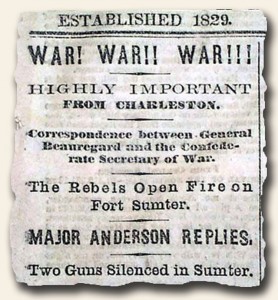 We at Timothy Hughes Rare & Early Newspapers have made a brief attempt at providing an overview of the Civil War via images of historic newspapers. These images may be viewed at: Rare Newspapers on Pinterest. We invite you to join with us in telling the story by going to www.rarenewspapers.com to find additional issues you believe should be added to “the story”. Feel free to provide us with the item number(s) of any you would like to have added. You may contact us by responding to this post or by e-mail (guy@rarenewspapers.com).
We at Timothy Hughes Rare & Early Newspapers have made a brief attempt at providing an overview of the Civil War via images of historic newspapers. These images may be viewed at: Rare Newspapers on Pinterest. We invite you to join with us in telling the story by going to www.rarenewspapers.com to find additional issues you believe should be added to “the story”. Feel free to provide us with the item number(s) of any you would like to have added. You may contact us by responding to this post or by e-mail (guy@rarenewspapers.com).
Robert E. Lee… a touching tribute…
April 27, 2012 by GuyHeilenman · 3 Comments
Buried deep within a September 3, 1868 issue of The New-York Times is a touching tribute to Robert E. Lee. This, along with several other articles from throughout the newspaper, provide a glimpse of this difficult post-Civil War period – with Nathan Bedford Forrest’s interview, the tension over support for Ulsysses S. Grant’s run for the Presidency, and reports from both the Republic and Democratic Party’s conventions providing the backdrop for this almost overlooked intimate letter from the editor of the Fredericksburg News.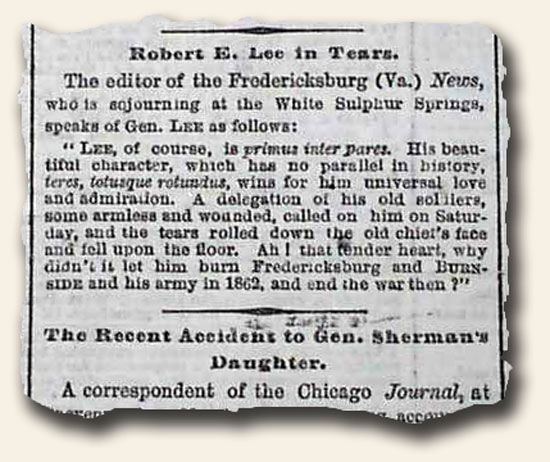
Southern Illustrated News images on Pinterest…
April 20, 2012 by GuyHeilenman · 2 Comments
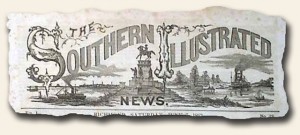 The Southern Illustrated News (Richmond, Virginia) was the Confederate counterpart to Harper’s Weekly Illustrated (NY, New York). While its distribution and duration were limited, the issues have become quite collectible. Portraits of Stonewall Jackson, Robert E. Lee, John S. Mosby, J.E.B Stuart, John H. Morgan, along with nearly every other notable figure from the Confederacy adorned the front page of this highly sought-after publication. Rare & Early Newspapers has taken on the task of posting images of every issue on Pinterest. While this project may take years, feel free to enjoy the progress to-date at: The Southern Illustrated News on Pinterest.
The Southern Illustrated News (Richmond, Virginia) was the Confederate counterpart to Harper’s Weekly Illustrated (NY, New York). While its distribution and duration were limited, the issues have become quite collectible. Portraits of Stonewall Jackson, Robert E. Lee, John S. Mosby, J.E.B Stuart, John H. Morgan, along with nearly every other notable figure from the Confederacy adorned the front page of this highly sought-after publication. Rare & Early Newspapers has taken on the task of posting images of every issue on Pinterest. While this project may take years, feel free to enjoy the progress to-date at: The Southern Illustrated News on Pinterest.
The Civil War… 150 years ago… March 1, 1862…
March 1, 2012 by GuyHeilenman · Leave a Comment
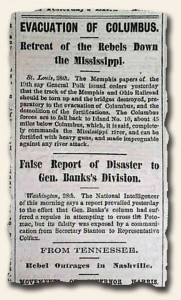 An ongoing reflection on the Civil War… 150 years prior to this post…
An ongoing reflection on the Civil War… 150 years prior to this post…
Arkansas, Tennessee, Virginia, North Carolina, Ohio… where was this war being fought? How are our loved ones doing? Are they near live action? Are they even still alive… or perhaps injured? Is the war coming to me? Are we safe? Will soldiers harm civilians? Will we ever be able to visit our relatives on the other side again? Would they even want to see us? What does all this mean? Today we look at original newspapers printed for March 1, 1862, and try to understand what it was like to walk in their shoes. Please enjoy:
Original Newspapers Read On March 1, 1862
“History is never more fascinating than when it’s read from the day it was first reported.”, Timothy Hughes, 1976


